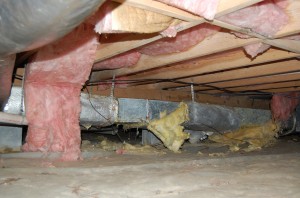During an energy audit I venture into crawl areas that often times have high levels of moisture and or bulk water problems. This is a problem that can go un-noticed for many years. The effects of this moisture can be damaging your house, is the cause of many health related problems, and causes comfort issues within the house. Many homeowners that I encounter with this problem have no idea that this is occurring or what the effects are from this condition.
Why do I inspect the underside of the house? It is necessary to inspect the crawl area during an energy audit for many reasons one of which is to check for moisture problems. The reason I check for this is to ensure that I do not draw moisture into the house during the blower door testing. The blower door may draw moisture into the wall cavities and house which could increase the possibility of mold growth. The same reason I check for gas leaks and CO levels, the homeowner’s safety and health is of utmost importance. To safely test houses is the mission of all properly trained energy auditors and building scientists.
The fact that moisture problems exist under your house is not that unusual in our area. What is surprising to me is that most homeowners are unaware of these problems. Don’t worry if you have no desire to go under your house, you’re not alone. Most people have never been under there house. This is an area though that should not be neglected.
Why do I care about moisture under my house? Excess moisture can cause rot & structural damage, pest infestation, and poor indoor air quality. What I am mostly concerned with during an energy audit is the indoor air quality, and the effects of moisture on how comfortable a house feels. If the RH (relative humidity) is above 60% then mold can grow. This mold growth and high RH, contributes to many health related problems like allergies and asthma. The effects of which can be devastating, especially for those that are sensitive to these conditions. High levels of RH also cause a house to feel cold and clammy in winter and uncomfortably sticky in summer. This condition causes the homeowner to be unhappy or dissatisfied with the performance of the HVAC equipment. This will prompt thermostat changes which can waste energy. In many instances the moisture simply needs to be removed.
Older houses are less likely to have problems with moisture because of air leakage. This allows the moisture to escape, but you have to heat and cool all that escaping air. So we have tightened our houses up to conserve energy, this traps moisture in the house. The answer to solving moisture problems is not always the same, but removing moisture from your home increases comfort, improves indoor air quality, and is directly related to energy conservation.

